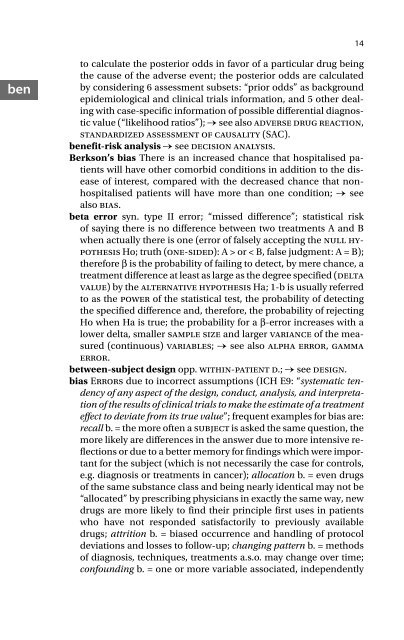220-Dictionary of Pharmaceutical Medicine, 2nd Edition-Gerhard Nahler Annette Mollet-3211898352-S
220-Dictionary of Pharmaceutical Medicine, 2nd Edition-Gerhard Nahler Annette Mollet-3211898352-S
220-Dictionary of Pharmaceutical Medicine, 2nd Edition-Gerhard Nahler Annette Mollet-3211898352-S
You also want an ePaper? Increase the reach of your titles
YUMPU automatically turns print PDFs into web optimized ePapers that Google loves.
14bento calculate the posterior odds in favor <strong>of</strong> a particular drug beingthe cause <strong>of</strong> the adverse event; the posterior odds are calculatedby considering 6 assessment subsets: “prior odds” as backgroundepidemiological and clinical trials information, and 5 other dealingwith case-specific information <strong>of</strong> possible differential diagnosticvalue (“likelihood ratios”); → see also adverse drug reaction,standardized assessment <strong>of</strong> causality (SAC).benefit-risk analysis → see decision analysis.Berkson’s bias There is an increased chance that hospitalised patientswill have other comorbid conditions in addition to the disease<strong>of</strong> interest, compared with the decreased chance that nonhospitalisedpatients will have more than one condition; → seealso bias.beta error syn. type II error; “missed difference”; statistical risk<strong>of</strong> saying there is no difference between two treatments A and Bwhen actually there is one (error <strong>of</strong> falsely accepting the null hypothesisHo; truth (one-sided): A > or < B, false judgment: A = B);therefore β is the probability <strong>of</strong> failing to detect, by mere chance, atreatment difference at least as large as the degree specified (deltavalue) by the alternative hypothesis Ha; 1-b is usually referredto as the power <strong>of</strong> the statistical test, the probability <strong>of</strong> detectingthe specified difference and, therefore, the probability <strong>of</strong> rejectingHo when Ha is true; the probability for a β-error increases with alower delta, smaller sample size and larger variance <strong>of</strong> the measured(continuous) variables; → see also alpha error, gammaerror.between-subject design opp. within-patient d.; → see design.bias Errors due to incorrect assumptions (ICH E9: “systematic tendency<strong>of</strong> any aspect <strong>of</strong> the design, conduct, analysis, and interpretation<strong>of</strong> the results <strong>of</strong> clinical trials to make the estimate <strong>of</strong> a treatmenteffect to deviate from its true value”; frequent examples for bias are:recall b. = the more <strong>of</strong>ten a subject is asked the same question, themore likely are differences in the answer due to more intensive reflectionsor due to a better memory for findings which were importantfor the subject (which is not necessarily the case for controls,e.g. diagnosis or treatments in cancer); allocation b. = even drugs<strong>of</strong> the same substance class and being nearly identical may not be“allocated” by prescribing physicians in exactly the same way, newdrugs are more likely to find their principle first uses in patientswho have not responded satisfactorily to previously availabledrugs; attrition b. = biased occurrence and handling <strong>of</strong> protocoldeviations and losses to follow-up; changing pattern b. = methods<strong>of</strong> diagnosis, techniques, treatments a.s.o. may change over time;confounding b. = one or more variable associated, independently


